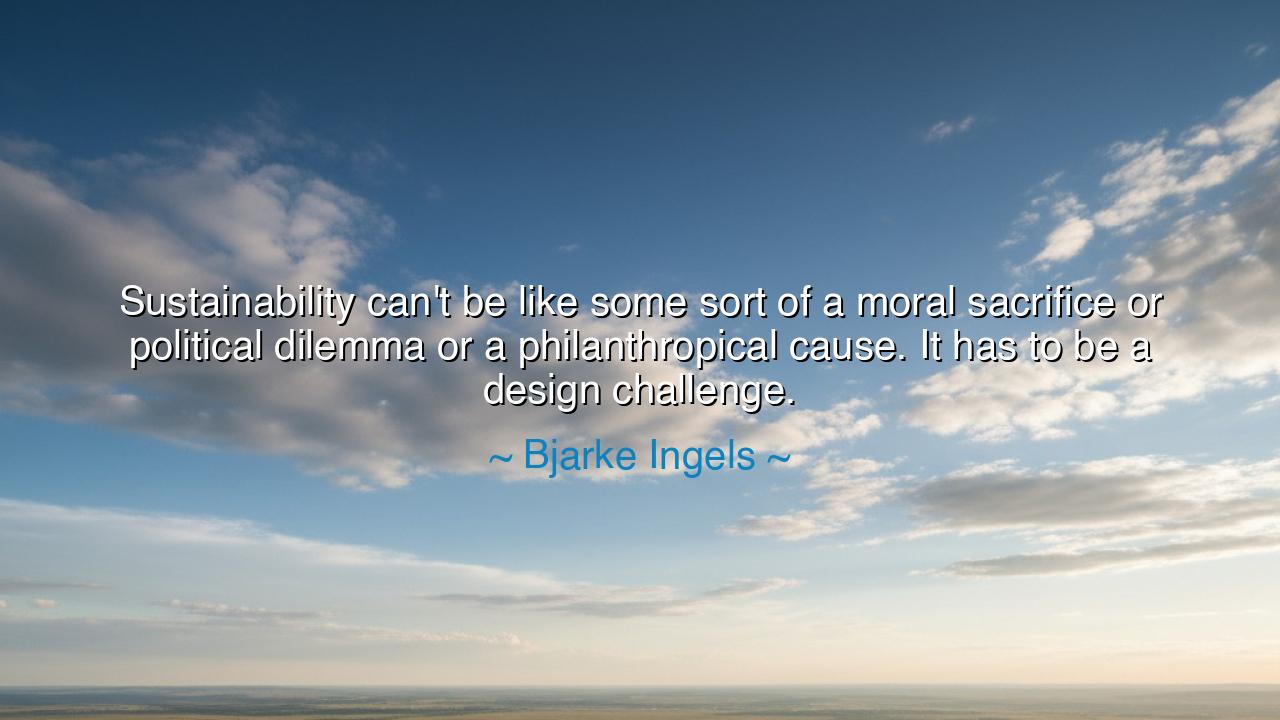
Sustainability can't be like some sort of a moral sacrifice or
Sustainability can't be like some sort of a moral sacrifice or political dilemma or a philanthropical cause. It has to be a design challenge.






Hearken, children of the ages, and let the words of Bjarke Ingels resonate in your hearts: “Sustainability can't be like some sort of a moral sacrifice or political dilemma or a philanthropical cause. It has to be a design challenge.” Understand this: the world is not saved by guilt, nor by endless debate, nor by the simple giving of coin. The Earth’s wounds are neither soothed nor healed by remorse alone. True transformation demands creativity, ingenuity, and the courage to face the problem not as a burden, but as a challenge to be solved. The ancients, who built temples and aqueducts, knew that enduring works arise not from moralizing, but from the art of careful design, harmonized with nature and necessity.
Consider the great civilizations of the past: the aqueducts of Rome, the terraces of Machu Picchu, the irrigation systems of Mesopotamia. These were not merely acts of charity or moral duty; they were design solutions to the pressing needs of human survival and prosperity. Each stone, each channel, each measured slope reflected deep observation, planning, and a vision for how people could thrive in harmony with the environment. Ingels reminds us that sustainability, too, must be approached in this way: with imagination, with rigor, and with the ambition to craft solutions that endure.
In the modern age, Bjarke Ingels himself exemplifies this philosophy through his architectural works. Take the CopenHill waste-to-energy plant in Denmark: a building that not only transforms waste into energy, but also serves as a public park, a ski slope, and a community space. This is sustainability reimagined, not as a moral imposition, but as a creative problem to solve. It embodies Ingels’ insight: when approached as a design challenge, environmental responsibility can be integrated into the very fabric of our lives, making it both practical and aspirational.
The lesson here is profound: sustainability cannot survive on moral exhortations alone. Just as a sword is not sharpened by words but by the steady hand of the craftsman, the future of the planet is shaped not by guilt, nor debate, but by deliberate design, experimentation, and innovation. The ancients would remind us that ingenuity is the truest ally of survival, and that human creativity, when applied to pressing challenges, can yield solutions both elegant and enduring.
Consider the example of Leonardo da Vinci, whose inventions and observations sought to harmonize human activity with the natural world. His designs for water systems, flying machines, and fortifications were all attempts to solve problems thoughtfully, merging art, science, and necessity. Ingels’ words echo this timeless truth: the path to sustainability lies not in moral posturing, but in the courage to confront reality with inventive solutions.
From this insight, a lesson emerges for all who seek to act responsibly: approach environmental challenges as a design problem, not a burden. Seek to innovate, to reimagine systems, to transform limitations into opportunities. Each project, each choice, each act of creation can be a step toward harmony with the Earth, if approached with the clarity and vision of a designer. Moral fervor alone is fleeting; design endures.
Practical action, therefore, requires imagination and diligence. Observe the world as it is, identify its pressures, and ask: how can I craft a solution that is elegant, functional, and sustainable? Engage collaborators, experiment boldly, and let creativity guide responsibility. Sustainability, when approached as a challenge to be solved, becomes a force that transforms both the environment and the communities that inhabit it.
Children of the ages, remember this: to save the world is not simply to feel guilt, nor to debate endlessly, nor to give. It is to design, to imagine, to craft systems and structures that endure and inspire. Let every act of creation be an act of stewardship, and in this way, the challenge of sustainability becomes not a burden, but a beacon of human ingenuity and hope for generations yet unborn.






AAdministratorAdministrator
Welcome, honored guests. Please leave a comment, we will respond soon